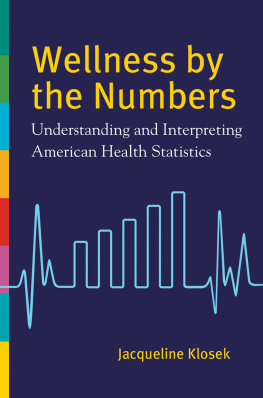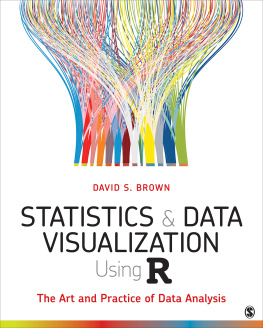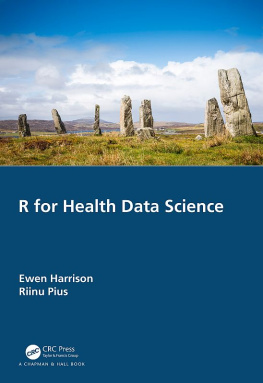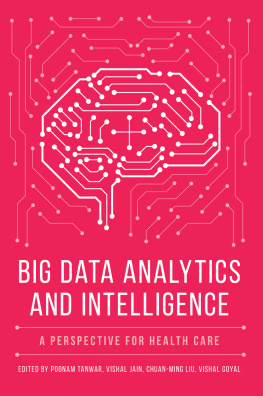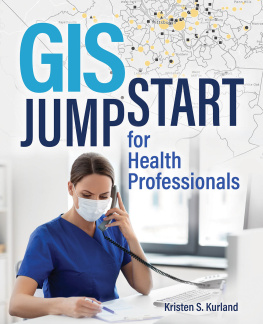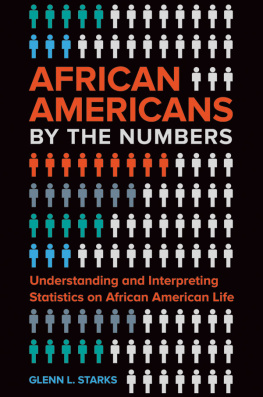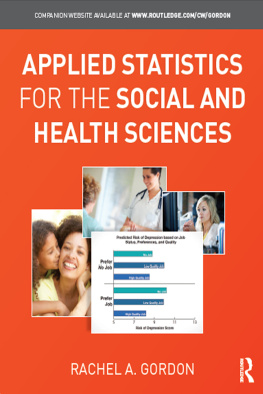WELLNESS BY THE NUMBERS
WELLNESS BY THE NUMBERS
Understanding and Interpreting American Health Statistics
JACQUELINE KLOSEK

Copyright 2015 by ABC-CLIO, LLC
All rights reserved. No part of this publication may be reproduced, stored in a retrieval system, or transmitted, in any form or by any means, electronic, mechanical, photocopying, recording, or otherwise, except for the inclusion of brief quotations in a review, without prior permission in writing from the publisher.
Library of Congress Cataloging-in-Publication Data
Klosek, Jacqueline, 1972
Wellness by the numbers : understanding and interpreting American health statistics / Jacqueline Klosek.
pages cm
Includes bibliographical references.
ISBN 978-1-61069-963-1 (hardback) ISBN 978-1-61069-964-8 (e-book) 1. Health status indicatorsUnited States. 2. DiseasesUnited StatesStatistics. 3. United StatesStatistics, Medical. I. Title.
RA407.3.K53 2015
614.42dc23 2014040151
ISBN: 978-1-61069-963-1
EISBN: 978-1-61069-964-8
19 18 17 16 15 1 2 3 4 5
This book is also available on the World Wide Web as an eBook.
Visit www.abc-clio.com for details.
Greenwood
An Imprint of ABC-CLIO, LLC
ABC-CLIO, LLC
130 Cremona Drive, P.O. Box 1911
Santa Barbara, California 93116-1911
This book is printed on acid-free paper 
Manufactured in the United States of America
This book is dedicated to my darling daughter Kayla Emerson Lozinski. You are the ultimate source of light, love, and inspiration. I love you more than words can say. May you always be blessed with the best of health.
Contents
Health Topics
Recently, the amount of money that Americans spend on health care exceeded $3.8 trillion. This astonishing figure demonstrates the high value that Americans place on good healthand the struggles that we are facing in achieving good health. Individuals are increasingly aware that with good health, they can feel better, look better, and live longer. Across the country, people are devoting time to reading health-related information, all in an effort to try to determine how to protect themselves from diseases, to uncover the latest ways to lose weight, and to identify the best diets that will help their bodies be stronger and live longer.
The media has responded to the concerns that we have about health optimization and today, we have incredible access to a deluge of health-related information. Magazines, books, television shows, websites, mobile applications, and social media services are all brimming with information about various health and medical information. And, yet, while there is this abundance of information available for consumption, it can be difficult for health care consumers to sort through what information is accurate, current, and credible. The best health information is based on scientific research, but occasionally scientific evidence can be misunderstood or misinterpreted by those reporting on it. Even worse, those with vested interests can sometimes purposefully mischaracterize research findings in order to serve their own purposes.
The goal of Wellness by the Numbers: Understanding and Interpreting American Health Statistics is to provide clear and concise information about certain key health issues. This book commences with a discussion on strategies for locating health-related information online and evaluating that information. The book then explores a number of key health topics, from maladies including various types of cancers, to discussions of topics that might lead to improved health, such as physical exercise and vitamin supplementation. Each section of the book defines and discusses one particular health indicator and then presents key data regarding that issue. Finally, each section concludes with discussion questions for further thought, investigation, and consideration.
Acknowledgments
I gratefully acknowledge the valuable assistance of Amanda Kontor, Carly Long, and Kevin Holton.
.
Understanding Web-Based Health-Related Information
Health-related information is easily accessible with todays technology; however, certain questions should be asked to evaluate the accuracy and currency of the provided information. Individuals should also recognize that determining the accuracy of health-related information can be difficult at times, even with credible sources of information. Conflicting information or differences of expert opinion may be found when a topic is newly researched, not yet fully understood, or can be treated in various ways. Therefore, it is always important to consult with an individuals medical practitioner before making any health-related decisions based on information that is found on the Internet. Yet, there are several ways to get a good understanding of health-related topics and to ensure that the information is credible. When relying on information from the Internet, individuals should ask the five Ws: who, what, when, where, and why.
How to Locate Accurate and Current Data
Determining who has posted the health information is an easy way to establish the accuracy of a site. Most websites will list the authors of the information, or the sponsors that provided the information. If no author or sponsor is provided, individuals can look for an About link to learn more about the purpose of the website and if the providers are credible. Additionally, examining the website URL can give an idea of whether the information is accurate. URLs that end in .gov are government-sponsored sites and can be trusted. URLs that end in .edu are educational institution sites and can be trusted, except when it is a personal page. URLs that end in .org are noncommercial organization sites and do not guarantee authorization, as they may provide false or biased information. URLs that end in .com are commercial organization sites and are the least trustworthy sites; however, hospitals may obtain a .com URL, so there are exceptions in verifying the accuracy of .com sites. By learning who has posted the health information, individuals can determine how the site is funded and if this factor affects the content that is provided. If the information was not posted by a reliable health-related source or known health organization, individuals can look for whether the information was reviewed by a medical expert or doctor. The credentials of the source may also be examined to determine whether the source has the required expertise to provide health-related information. If the information has undergone peer review, that further enhances the accuracy of the information. Additionally, contact information of the source, which is usually located at the bottom of the page, also enhances the accuracy of the information.
What the information says is also important in determining accuracy and currency. When reading through the information, individuals should make sure that proper grammar and punctuation are used. Sensational writing styles should be avoided. Also, information should not appear to be opinion based. All facts and statistics should be cited and refer to an original scientific study or medical expert.
Determining when the information was originally posted or last reviewed will help ensure the currency of the information. Health information changes constantly, as researchers are continuously making new health-related discoveries that are being posted across the Internet. Individuals should check the date of when the information was originally posted or last reviewed, which is usually provided at the bottom of the page. If this information is not provided, they should look for the copyright line, which informs when the original information was posted. Individuals should try to find health-related information that was reviewed within the past year to ensure its currency. Another way to check the currency of the information is to click on links that are provided on the page to ensure that they are not broken links, as that can signify that the site is not current.
Next page
